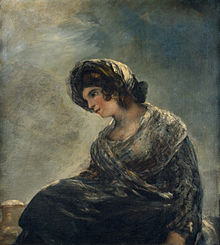User:Cyuanfr/波尔多的卖牛奶姑娘
| 波尔多的卖牛奶姑娘 | |
|---|---|
| 西班牙语:La lechera de Burdeos | |
 | |
| 藝術家 | 弗朗西斯科·戈雅 |
| 年份 | 1825–1827年 |
| 尺寸 | 74 cm × 68 cm(29英寸 × 27英寸) |
| 收藏地 | 马德里普拉多博物馆 |
波尔多的牛奶女工(西班牙语:La lechera de Burdeos)[1]是一幅完成于1825年至1827年间的油画,通常被认为是西班牙艺术家弗朗西斯科·戈雅(1746-1828年)的作品。这幅画被认为是戈雅的最后作品之一,完成于他去世的前一年,被认为是戈雅的杰作之一。[2][3]
争议 编辑
Although the picture is held in great esteem and widely admired by critics and the public, doubt has been cast by art historians as to whether it is an actual Goya.[4] If authentic then it is likely a portrait of either Rosario Weiss, or more likely, her mother Leocadia Weiss—the artist's nurse during the last years of his life. Leocadia cared for Goya in exile in Bordeaux, where he settled to live among politically liberal friends.[5] The true nature of the relationship between Goya and Leocadia is unknown due to a lack of documentation, and while many sources refer to Leocadia as a nurse or housekeeper, others believe her to be Goya's mistress.[6][7] 尽管这幅画受到评论家和公众的高度赞赏和广泛欣赏,但艺术史学家对它是否真正是戈雅的作品提出了质疑。如果真实的话,那么它很可能是罗萨里奥·韦斯(Rosario Weiss)的肖像,或者更有可能是她的母亲莱奥卡迪亚·韦斯(Leocadia Weiss)——在他生命的最后几年里担任他的护士的艺术家。莱奥卡迪亚在戈雅流亡波尔多期间照顾了戈雅,他在那里定居并与政治上自由的朋友们生活在一起。由于缺乏文件记录,戈雅和莱奥卡迪亚之间的真实关系尚不清楚,虽然许多资料称莱奥卡迪亚是一位护士或管家,但也有人认为她是戈雅的情妇。
Following his death, the painting was willed to his last child, Javier (b. 1784). Financial difficulties a year later forced him to sell it to Juan Bautista de Muguiro, a distant relative. Muguiro's descendants donated the work to the Museo del Prado in 1946,[1] where it remains a popular exhibit at the gallery, despite doubts as to its origin. While being widely admired by art historians and the public alike, The Milkmaid of Bordeaux remains one of Goya's works that is infrequently discussed, perhaps because it is considered not as ambitious as his other works. [8] 在戈雅去世后,这幅画被遗赠给了他最后的孩子哈维尔(出生于1784年)。一年后,由于经济困难,他不得不将其卖给胡安·鲍蒂斯塔·德·穆吉罗(Juan Bautista de Muguiro),一个远房亲戚。穆吉罗的后代于1946年将这幅作品捐赠给了普拉多博物馆,它至今仍然是该画廊的一件受欢迎的展品,尽管对其起源存有疑虑。尽管《波尔多挤奶女工》受到艺术史学家和公众的广泛赞赏,但它仍然是戈雅的作品中很少被讨论的作品之一,可能是因为人们认为它不像他的其他作品那样雄心勃勃。
Rosario was later a painter, and it is sometimes claimed that she may have been the creator of this work. However, when compared to the relatively amateur works of hers held in the Academia de San Fernando, it is generally considered highly unlikely.[9] It has also been argued that Rosario is in fact Goya's illegitimate daughter, but those claims are unsubstantiated, and it is highly unlikely, given that Leocadia was living with her husband at the time.[10]
作品赏析 编辑
While not his most famous painting, The Milkmaid of Bordeaux is considered a technical masterpiece, and one of his technically best works. [11] This portrait features a young woman wrapped in a shawl that Goya had likely bought himself, as mentioned in a letter from Leandro Fernandez de Moratin to Juan Antonio Melón. [12] The work is his last portrait of a woman before his death. [13]
The Milkmaid of Bordeaux has been interpreted as an ode to youth by an old man in failing health. [13] Its brightness is such a departure in tone from his famous black paintings that it has been argued that Goya is not the artist of the painting, though this claim has little support. [14] The brushstrokes and coloring of the painting speaks to Goya's mastery of technique.[11]
While in Bordeaux during the last years of his life, Goya made several works that reflect the daily life of ordinary people, some of which have been interpreted as a reflection of Goya's faith in humanity, this work included.[11] The portrait itself is of a young woman, presumably a milkmaid or peasant, appearing to sit in contemplation with her head lowered. [15][14] [11] Her hair is partially covered in a scarf, a shawl wraps around her shoulders, and an apron sits on her lap.[15] Beside the woman, on the bottom left of the painting, sits what appears to be a milk jug or container of some kind. [15] The sky in the background is just a blur of colors, and the position of the woman has been interpreted as implying that she is actually riding on a mule, though it, as well as her hands, are not visible in the painting. [15] [14]
参见 编辑
参考来源 编辑
- ^ 1.0 1.1 Hughes, 402
- ^ Felisati, D.; Sperati, G. Francisco Goya and his illness. Acta Otorhinolaryngologica Italica. 5 October 2010, 30 (5): 264–270. PMC 3040580 . PMID 21804693.
- ^ Junquera, Juan José. The Black Paintings of Goya. London: Scala Publishers Ltd. 2003: 21–23.
- ^ Hughes, 25
- ^ Hagen & Hagen, 95
- ^ Posèq, Avigdor W. G. The goat in Goya's 'witches' sabbaths'. Source: Notes in the History of Art. July 1999, 18 (4): 30–39. S2CID 192957288. doi:10.1086/sou.18.4.23206811.
- ^ Junquera, Juan José. The Black Paintings of Goya. London: Scala Publishers Ltd. 2003: 21–23.
- ^ Licht, Fred. Goya: The Origins of the Modern Temper in Art. New York, NY: Universe Books. 1979: 269. ISBN 0-87663-294-0.
- ^ Junquera, 21
- ^ Junquera, Juan José. The Black Paintings of Goya. London: Scala Publishers Ltd. 2003: 21–23.
- ^ 11.0 11.1 11.2 11.3 Klindgender, Francis Donald. Goya in the Democratic Tradition. London: Sidgwick and Jackson Limited. 1948: 212.
- ^ Junquera, Juan José. The Black Paintings of Goya. London: Scala Publishers Ltd. 2003: 21–23.
- ^ 13.0 13.1 Baticle, Jeannine. Goya: Painter of Terrible Splendor. New York: Harry N. Abrams. 1994: 124–127. ISBN 0-8109-2818-3.
- ^ 14.0 14.1 14.2 Delbanco, Nicholas. LASTINGNESS: THE ART OF OLD AGE. Michigan Quarterly Review. Summer 2009, 48 (3). hdl:2027/spo.act2080.0048.311. ProQuest 232309143.
- ^ 15.0 15.1 15.2 15.3 The Milkmaid of Bordeaux - The Collection - Museo Nacional del Prado. www.museodelprado.es. [2022-04-22].
戈雅的传记 编辑
- Connell, Evan S. Francisco Goya: A Life. New York: Counterpoint, 2004. ISBN 1-58243-307-0
- Hagen, Rose-Marie & Hagen, Rainer. Francisco Goya, 1746-1828. Taschen, 2003. ISBN 3-8228-1823-2
- Hughes, Robert. Goya. New York: Alfred A. Knopf, 2004. ISBN 0-394-58028-1
- Junquera, Juan José. The Black Paintings of Goya. London: Scala Publishers, 2008. ISBN 1-85759-273-5
External links 编辑
- 维基共享资源上的相關多媒體資源:Cyuanfr/波尔多的卖牛奶姑娘